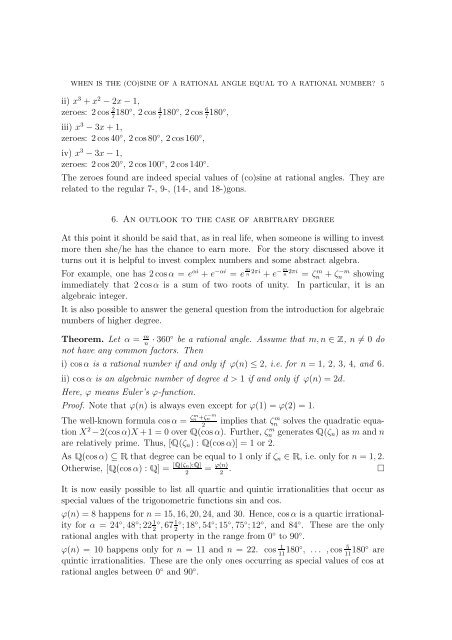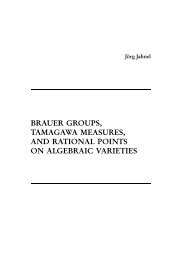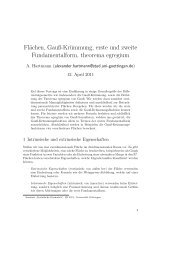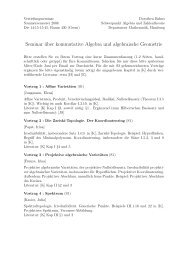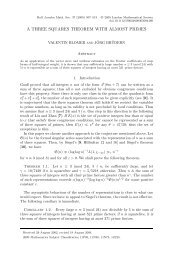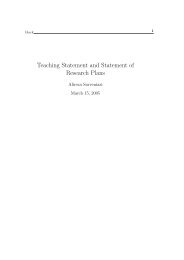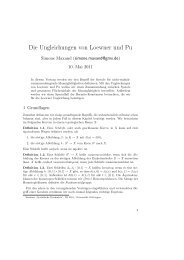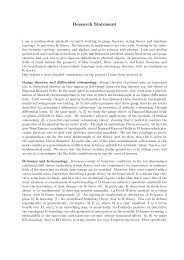SINE OF A RATIONAL ANGLE EQUAL TO A RATIONAL NUMBER?
SINE OF A RATIONAL ANGLE EQUAL TO A RATIONAL NUMBER?
SINE OF A RATIONAL ANGLE EQUAL TO A RATIONAL NUMBER?
Create successful ePaper yourself
Turn your PDF publications into a flip-book with our unique Google optimized e-Paper software.
WHEN IS THE (CO)<strong>SINE</strong> <strong>OF</strong> A <strong>RATIONAL</strong> <strong>ANGLE</strong> <strong>EQUAL</strong> <strong>TO</strong> A <strong>RATIONAL</strong> <strong>NUMBER</strong>? 5<br />
ii) x 3 + x 2 − 2x − 1,<br />
zeroes: 2 cos 2 7 180◦ , 2 cos 4 7 180◦ , 2 cos 6 7 180◦ ,<br />
iii) x 3 − 3x + 1,<br />
zeroes: 2 cos40 ◦ , 2 cos80 ◦ , 2 cos 160 ◦ ,<br />
iv) x 3 − 3x − 1,<br />
zeroes: 2 cos20 ◦ , 2 cos100 ◦ , 2 cos140 ◦ .<br />
The zeroes found are indeed special values of (co)sine at rational angles. They are<br />
related to the regular 7-, 9-, (14-, and 18-)gons.<br />
6. An outlook to the case of arbitrary degree<br />
At this point it should be said that, as in real life, when someone is willing to invest<br />
more then she/he has the chance to earn more. For the story discussed above it<br />
turns out it is helpful to invest complex numbers and some abstract algebra.<br />
For example, one has 2 cosα = e αi + e −αi = e m n 2πi + e − m n 2πi = ζn m + ζ n<br />
−m showing<br />
immediately that 2 cosα is a sum of two roots of unity. In particular, it is an<br />
algebraic integer.<br />
It is also possible to answer the general question from the introduction for algebraic<br />
numbers of higher degree.<br />
Theorem. Let α = m n · 360◦ be a rational angle. Assume that m, n ∈, n ≠ 0 do<br />
not have any common factors. Then<br />
i) cosα is a rational number if and only if ϕ(n) ≤ 2, i.e. for n = 1, 2, 3, 4, and 6.<br />
ii) cosα is an algebraic number of degree d > 1 if and only if ϕ(n) = 2d.<br />
Here, ϕ means Euler’s ϕ-function.<br />
Proof. Note that ϕ(n) is always even except for ϕ(1) = ϕ(2) = 1.<br />
The well-known formula cosα = ζm n +ζn<br />
−m<br />
implies that ζ m 2 n solves the quadratic equation<br />
X 2 −2(cos α)X +1 = 0 overÉ(cos α). Further, ζn m generatesÉ(ζ n ) as m and n<br />
are relatively prime. Thus, [É(ζ n ) :É(cos α)] = 1 or 2.<br />
AsÉ(cosα) ⊆Êthat degree can be equal to 1 only if ζ n ∈Ê, i.e. only for n = 1, 2.<br />
Otherwise, [É(cosα) :É] = [É(ζ n):É]<br />
= ϕ(n) . □<br />
2 2<br />
It is now easily possible to list all quartic and quintic irrationalities that occur as<br />
special values of the trigonometric functions sin and cos.<br />
ϕ(n) = 8 happens for n = 15, 16, 20, 24, and 30. Hence, cosα is a quartic irrationality<br />
for α = 24 ◦ , 48 ◦ ;22 1 ◦ , 67 1 ◦ ;18 ◦ , 54 ◦ ;15 ◦ , 75 ◦ ;12 ◦ , and 84 ◦ . These are the only<br />
2 2<br />
rational angles with that property in the range from 0 ◦ to 90 ◦ .<br />
ϕ(n) = 10 happens only for n = 11 and n = 22. cos 1<br />
11 180◦ , . . . , cos 5 11 180◦ are<br />
quintic irrationalities. These are the only ones occurring as special values of cos at<br />
rational angles between 0 ◦ and 90 ◦ .


